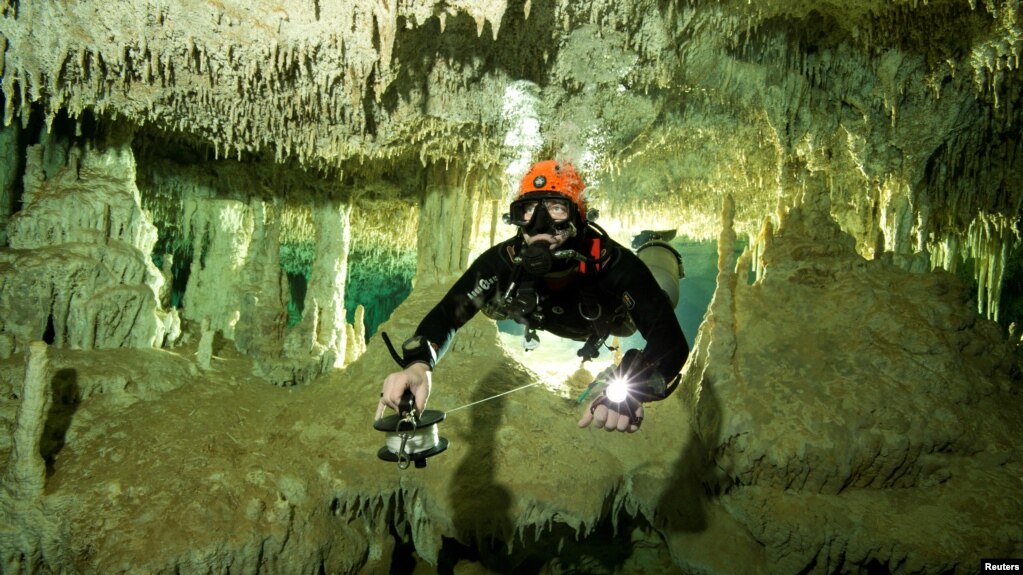
Posted on 02/20/2018 9:40:30 AM PST by Red Badger

FILE - A scuba diver measures the length of Sac Aktun underwater cave system as part of the Gran Acuifero Maya Project near Tulum, in Quintana Roo state, Mexico, Jan. 24, 2014. Herbert Mayrl/Courtesy Gran Acuifero Maya Project (GAM) handout. _________________________________________________________________________________________________________________________________
MEXICO CITY —
Items discovered underwater caverns in eastern Mexico to reveal what is believed to be the biggest flooded cave on the planet
Archaeologists exploring the world's biggest flooded cave in Mexico have discovered ancient human remains at least 9,000 years old and the bones of animals who roamed the Earth during the last Ice Age.
A group of divers recently connected two underwater caverns in eastern Mexico to reveal what is believed to be the biggest flooded cave on the planet, a discovery that could help shed new light on the ancient Maya civilization.
The Yucatan peninsula is studded with monumental relics of the Maya people, whose cities drew upon an extensive network of sinkholes linked to subterranean waters known as cenotes.
Researchers say they found 248 cenotes at the 347-km (216-mile) cave system known as Sac Actun, near the beach resort of Tulum. Of the 200 archaeological sites they have discovered there, around 140 are Mayan.
Some cenotes acquired particular religious significance to the Maya, whose descendants continue to inhabit the region.
Apart from human remains, they also found bones of giant sloths, ancient elephants and extinct bears from the Pleistocene period, Mexico's Culture Ministry said in a statement.
The cave's discovery has rocked the archaeological world.
"I think it's overwhelming. Without a doubt it's the most important underwater archaeological site in the world," said Guillermo de Anda, researcher at Mexico's National Anthropology and History Institute (INAH).
De Anda is also director of the Gran Acuifero Maya (GAM), a project dedicated to the study and preservation of the subterranean waters of the Yucatan peninsula.
According to the INAH, water levels rose 100 meters at the end of the Ice Age, flooding the cave system and leading to "ideal conditions for the preservation of the remains of extinct megafauna from the Pleistocene."
The Pleistocene geological epoch, the most recent Ice Age, began 2.6 million years ago and ended around 11,700 years ago.
First of all the catastrophe that biblical scholars referred to as being about 14,000ya was probably the same catastrophe, that Sunken Civ has frequently posted the book by Firestone et al to illustrate. That event destroyed the Clovis culture, and killed so many large mammals that only small numbers survived for long afterward and probably died off from having too few members left to breed. About a century before Cortez showed up in Mexico, a chief advisor told his ruler that they should make their neighbors be their bread. Thus wars were fought against neighboring tribes and captive warriors “honored” by being sacrificed ritually and then eaten. The tortilla is the “bread” of Mexico, and in Aztec (Nahuatl) is tlascalli. Cortez met a neighboring tribe called the Tlascallans who contributed thousands of warriors to help Cortez cut off the “bread” supply. I don’t know which came first, the name for bread or the name for the tribe. In addition Aztecs ate turkey (guajalote), ducks, fish, frogs, and bugs.
The water level in the caves is related to the sea level in the Caribbean and Gulf of Mexico. After serious cataclysm around 13,000 ya, a long (1,000 year) cold period called the Younger Dryas stopped the thawing of the Ice Age. Sea level probably fell again, and when things finally started thawing again, the sea level rose, and the water table (fresh water inland) rose also. There may have been other “Great Floods” but this was probably not it.
The range for coyote reaches the Panama Canal today; that was considered a game animal as well as whatever domesticated dogs were around. The food supply and water supply across a wide band tended (still does) to restrict the distribution of bear.
As glee' noted, the Aztecs hit the all-time height (even in the Americas) for human sacrifice. There was a long structure in the plaza in front of the big pyramid in Tenochtitlan, the Aztec word for it meant "the corncrib" -- the Spanish were appalled that it was chock-a-block full of defleshed human remains in the 100s of 1000s. The Aztecs called their predation "Flower Wars", and as glee' noted, there was no lack of native allies to resist the Aztecs when Cortez first arrived.
During the flight out of the city and back to their landing site (Veracruz, I believe), expedition member Bernal Diaz wrote that the towns they'd previously passed through were emptied out, which apparently was a consequence of the incidental introduction of diseases new to the local populations.
Sugar. And the usual gland problem. They’ll need a crane to get him over trumps wall. Or roll him north.
Disclaimer: Opinions posted on Free Republic are those of the individual posters and do not necessarily represent the opinion of Free Republic or its management. All materials posted herein are protected by copyright law and the exemption for fair use of copyrighted works.